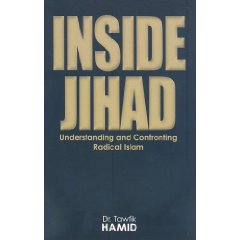|
Reviewed by Raymond R. Ibrahim, Independent scholar and editor of The Al-Qaeda Reader, Washington, DC Several singular reasons make Inside Jihad: Understanding and Confronting Radical Islam by Dr. Tawfik Hamid a welcome contribution to the otherwise growing lore on radical Islam. Tawfik himself is a former jihadist and onetime member of Egypt’s infamous Islamist group al-Gam’a al-Islamiyya, which, among other notorieties, was responsible for the 1997 Luxor massacre where fifty-eight foreign (mostly European) tourists where butchered (to Hamid’s credit, he abandoned the organization well before it took to such extreme acts of terror). More intriguing is the fact that he met and was “mentored” by none other than al-Qaeda leader and Islamic ideologue Dr. Ayman Zawahiri. These two aspects alone place Hamid in a privileged position to comment on radical Islam; he is not simply talking out of “theory” but real life immersion and experience. But what make his observations more noteworthy is the fact that, as a medical doctor with a background in psychology, he approaches his subject objectively (medical training) as well as gives a meticulous account of the jihadist mentality and the phases it goes through (psychological training). Hamid’s professional background further allows him to make valuable use of medical analogies to better illustrate his point—not unlike his former mentor and fellow doctor, Zawahiri. Ironically (and surely unknowingly) both doctors offer medical imagery to combat each other’s views. Warning the umma from those who “cloak themselves in the garb of Islam worming their way into the umma’s beliefs, mind, and heart,” Zawahiri likens reformers such as Hamid to “lethal bacteria, trying to overcome the human immune system, trying to destroy it to sow corruption in the cells of the human body” (The Al Qaeda Reader, p. 104). But Hamid’s metaphors are more poignant and instructive. After accurately likening radical Islam to a “cancerous cell” within the Islamic body, he goes on to discuss Western “myths and misconceptions” regarding the spread of this cancer (i.e., that Islamist terror is the inevitable byproduct of poverty, discrimination, ignorance, absence of democracy, colonialism, the Arab-Israeli conflict, U.S. foreign policy, et. al.). He then reminds us that “Every medical doctor [i.e., people who truly apply the “scientific method”] will assert that it is very difficult to treat a disease if it is misdiagnosed or if the disease is confused with symptoms. If we misdiagnose, then we treat the wrong illness. If we confuse the roots of the illness or superficially mask its symptoms, we cannot effect [sic] a cure. The same applies to the societal disease of terrorism.” Bringing his psychological background in play, Hamid carefully delineates the phases of radicalization—from hatred to suppression of conscience to desensitization to violence—with a stress on how radicals seek to suppress the human capacity for critical thinking, well demonstrated by a telling dialogue with a senior member of al-Gam’a who once explained to him that “One’s brain is similar to a donkey…you can ride it to the palace of Allah, but you must leave it outside when you enter.” Hamid also demonstrates how weak U.S. military responses coupled with apologetic behavior serve to, not only embolden current jihadists, but also motivate on-the-fence Muslims into joining their ranks: “If terrorists saw that Americans were demonstrating against them—instead of demonstrating against their own country—they would have felt defeated at the ‘mental level’ and the number of terrorist attacks would have declined.” And so “After the publications, in 2005, of the Muhammad cartoons by a Danish newspaper, Muslim riots started in earnest only after the paper issued an apology.” That passive and apologetic behavior only emboldens aggressive behavior may be obvious to some; coming from a former radical who lived decades among them, however—in other words, from someone who truly knows firsthand—lends it greater significance. Here too Hamid offers an objective assessment of Western reticence and apologetic behavior through the use of a particularly potent analogy: “The inadequate American answer to terrorism can be likened to an insufficient use of antibiotics to treat an infection: it does not cure the disease and at the same time it allows the emergence of resistant strains. The same applies to military responses. One must either conduct them in a potent and focused manner or not engage the enemy at all. Using insufficient power aggravates the problem because it reveals to jihadists their enemy’s constraints and vulnerabilities.” Inside Jihad offers other valuable lessons and insights. Whole chapters and segments are devoted to hitherto over-looked aspects of radical Islam. For instance, Hamid discusses in detail the phenomenon of “passive terrorism,” the theory that Muslims who do not vociferously denounce terror in the name of Islam with the same verve and fervor produced by caricatures of Mohammad, only contribute to more terrorism. Hamid also makes the intriguing observation that“the proliferation of the hijab is strongly correlated with increased terrorism…. Terrorism became much more frequent in such societies as Indonesia, Egypt, Algeria, and the U.K. after the hijab became prevalent among Muslim women living in those communities.” Finally, it is encouraging to see someone openly and honestly castigate certain aspects of Islam and Muslims—and not simply dismiss them as products of “exegetical misinterpretation” by a “few” Muslims, as many apologists insist—and yet still be devoted to his faith. Instead of equivocating, Hamid admits Islam’s shortcoming, but offers “a theologically rigorous re-interpretation of Islamic texts…to bring about reformation.” In this short primer alone, he introduces fresh—and compelling—re-interpretations of core Islamic texts relating to jihad (e.g., the fact that the definite article “al”—not the more open-ended “min” (whoever)—always precedes words such as “kuffura” or “mushrikin” (that is, infidels and idolaters) in the Koran and thus places Islam’s “sword verses” in a historical context, limited in time and space. By presenting different perspectives and aspects and, most importantly, by being written by someone “different”—a former jihadist “in-the-know”—Inside Jihad offers very unique insights into radical Islam and jihad. |


 Inside Jihad: Understanding and Confronting Radical Islam
Inside Jihad: Understanding and Confronting Radical Islam